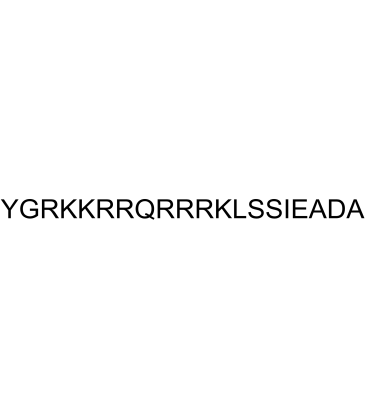847829-41-8
| Name | Tat-NR2Baa |
|---|
| Description | Tat-NR2BAA is the control peptide of Tat-NR2B9c (HY-P0117), inactive. The sequence of Tat-NR2BAA is similar to Tat-NR2B9c, but it has a double-point mutation in the COOH terminal tSXV motif, making it incapable of binding PSD-95. Tat-NR2B9c is a membrane-permeant peptide and disrupts PSD-95/NMDAR binding, correlate with uncoupling NR2B- and/or NR2A-type NMDARs from PSD-95[1][2]. |
|---|---|
| Related Catalog | |
| In Vitro | Tat-NR2BAA (125 ng; 20 mins) does not effects interactions between PSD-95 and NR2B subunits. In contrast, coimmunoprecipitation of PSD-95 with NR2B subunits is markedly decreased in rats pretreated with the disrupting peptide Tat-NR2B9c in lumbar dorsal horn tissue[1]. Tat-NR2Baa (125 ng or 1.25 μg; 20 minutes before collection of lumbar dorsal horn tissue) is the control group of Tat-NR2B9c. Tat-NR2B9c produces a significant and robust reduction of postdischarge, indicating the hyperexcitability of the cell. But Tat-NR2Baa has no effects, even at a dose 100× greater than the active peptide Tat-NR2B9c (HY-P0117)[1]. Tat-NR2Baa (1 μM; pre-treatment 1 hour) is the control group in the Co-IP assay. Tat-NR2B9c (1 μM) disrupts NR2B/PSD95 interaction, and the coupling of NR2B to PSD-95 is more sensitive than NR2A/PSD95 to disruption in hippocampal neurons[2]. |
| References |
| Molecular Formula | C103H184N42O29 |
|---|---|
| Molecular Weight | 2474.83 |

